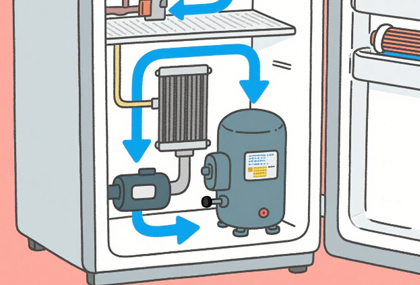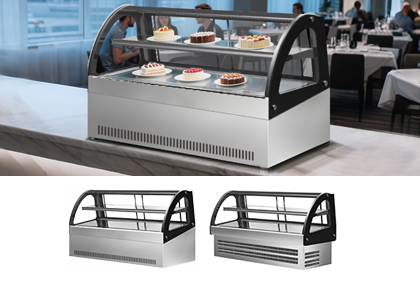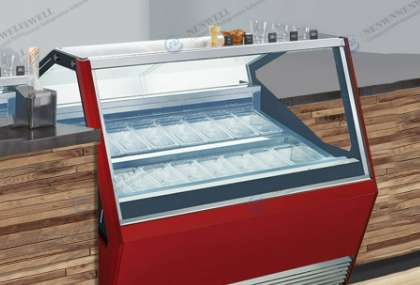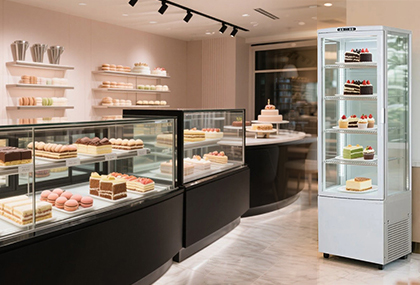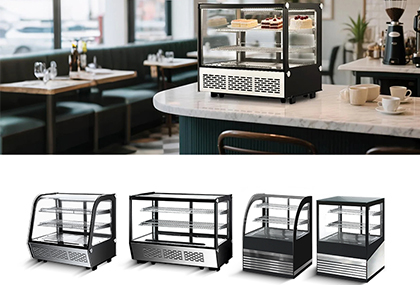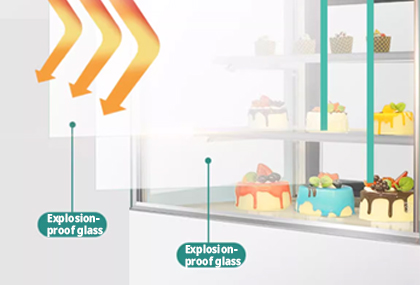Where Lies the Value of the Best Cake Display Showcase?
The value of high-end cake display showcases lies in a series of functions including preservation, display, and storage. Their significance extends far beyond mere refrigeration. These commercial devices are centered around visual presentation, supported by professional functions, and infused with brand identity. They serve as crucial tools for shaping brand images and play an irreplaceable role in high-end cake shops, chain bakery brands, mall dessert counters, and other settings.
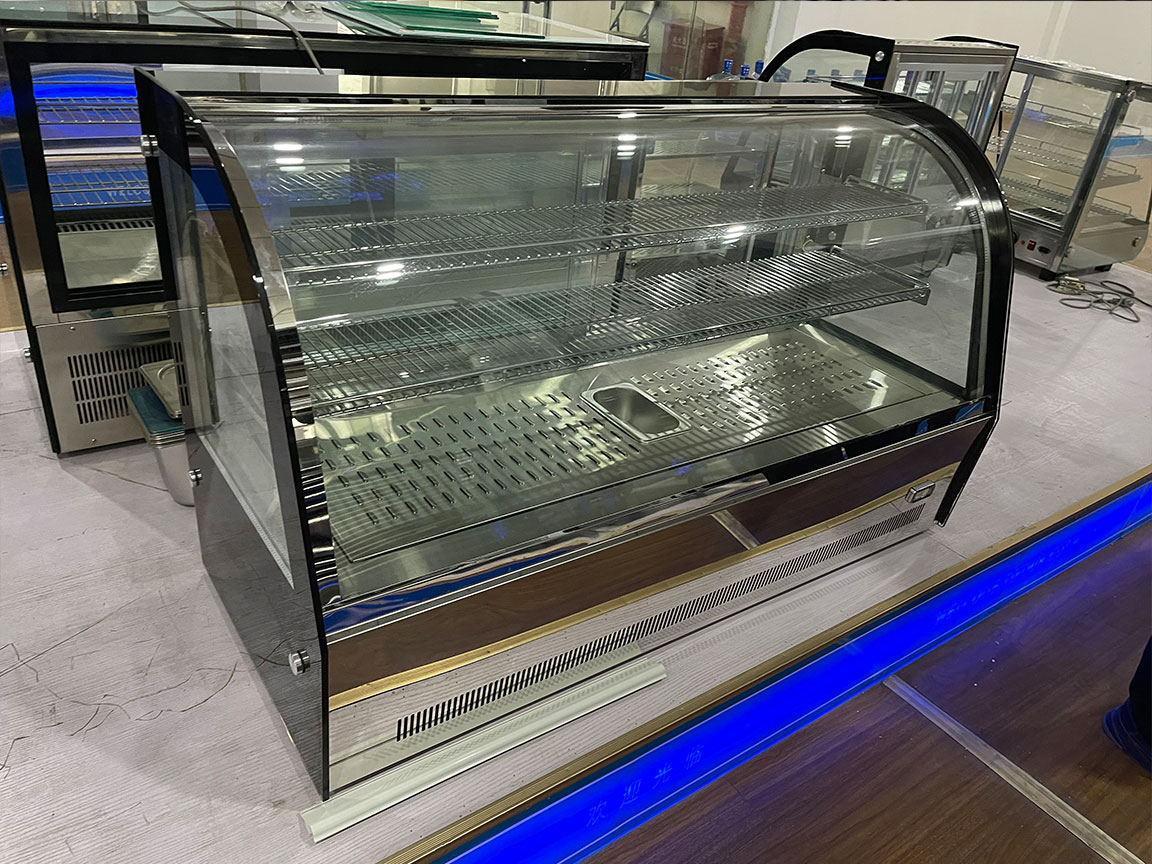
I. The Core Positioning of Commercial High-End Cake Display Showcases: From "Storage" to "Value Amplification"
To understand the uniqueness of commercial high-end cake display showcases, it's essential to first grasp their fundamental differences from ordinary ones. Ordinary display cases aim to "meet basic refrigeration and display needs" with simple designs and limited functions. In contrast, commercial high-end showcases focus on "amplifying the value of cakes," achieving the marketing effect of "letting the cakes speak for themselves" through deep adaptation of design, functions, and scenarios.
From a business perspective, the core positioning of high-end cake display showcases encompasses three dimensions:
1.Visual Marketing Carrier: Consumer decisions regarding baked goods rely heavily on "visual appeal." The delicate texture of cream, the fresh color of fruits, and the intricate details of icing all need to be "enhanced" through professional display showcases. For example, the layered texture of a mousse cake may appear ordinary in a common glass case, but in a high-end showcase equipped with customized lighting and ultra-clear glass, its layered beauty can be vividly presented, stimulating consumers' purchasing impulse.
2.Professional Preservation Guarantee: High-end cakes (such as French mousses, cheesecakes, and custom cream cakes) have much higher requirements for storage environments compared to ordinary pastries. The temperature fluctuation needs to be controlled within ±1℃, and the humidity should be maintained between 60% - 70%. Otherwise, issues like cream melting, cake cracking, and deteriorated taste may occur. One of the core functions of high-end display showcases is to ensure product quality during "display" through precise temperature and humidity control, avoiding losses caused by improper storage.
3.Brand Image Extension:The store designs of high-end bakery brands often pursue "integrated aesthetics." As the core display equipment, the style, material, and craftsmanship of the display showcase need to highly match the brand's tone. For instance, a cake brand with a "luxury ins style" may choose a display showcase with curved glass and matte stainless steel, while a bakery with an "industrial style" might opt for a design with a black metal frame and transparent acrylic panels, making the display showcase an integral part of the brand's visual system.
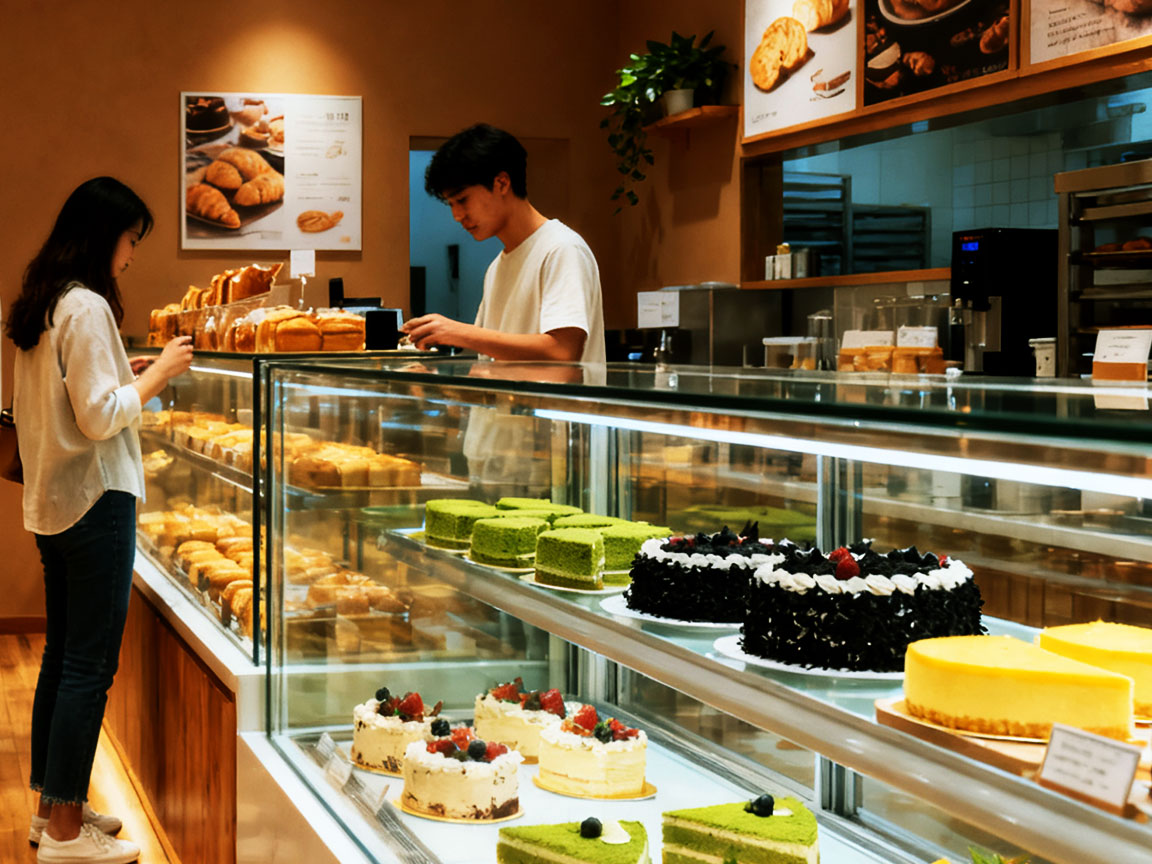
II. The Design Core of Commercial High-End Cake Display Showcases: Details Determine "Visual Premium"
If the design of ordinary display cases is about "being functional," then the design of high-end showcases ensures "every detail serves marketing." Its design logic revolves around "maximizing visual appeal," mainly reflected in the professional control of four dimensions: materials, lighting, structure, and style.
(I) Materials: Balancing Texture and Practicality
The material selection for high-end display showcases needs to meet both the requirements of "visual sophistication" and "commercial durability." Common core materials include:
1.Stainless Steel
Different from the 201 stainless steel commonly used in ordinary display cases (which is prone to rust and has a rough texture), high-end display showcases mostly use 304 or 316 food-grade stainless steel. 304 stainless steel is corrosion-resistant, easy to clean, and has high gloss. Even with long-term exposure to cake residues and condensed water, it is not likely to rust.
316 stainless steel is more suitable for humid environments (such as stores in coastal cities in southern China) due to its stronger salt spray resistance. Additionally, high-end products often undergo "matte brushing" or "mirror polishing" treatments on stainless steel. The matte brushing texture is understated and suitable for a luxury style, while mirror polishing can reflect light, enhancing the spatial transparency.
2.Glass
Ordinary display cases mostly use common float glass with a light transmittance of about 80%, and they are prone to reflection and color distortion. In contrast, high-end display showcases commonly use "ultra-clear glass" (with a light transmittance of over 92%), which can restore the true colors of cakes to the greatest extent, avoiding the "grayish" appearance of cream caused by the greenish tint of ordinary glass. Moreover, curved glass is one of the signature designs of high-end models. Compared with right-angled glass, curved glass reduces visual blind spots, allowing consumers to see the details of cakes from any angle, and its curved lines exude a softer, more refined feel that aligns with the "delicacy" of baked goods. Some high-end products also have an anti-fog film coated on the inner side of the glass to prevent water mist caused by temperature differences and ensure the stability of the display effect.
3.Shelf Boards and Frames
Shelf boards are the core carriers for displaying cakes. High-end display showcases mostly use "tempered glass shelf boards" or "acrylic shelf boards." Tempered glass has strong load-bearing capacity (each piece can bear 5 - 8 kg), making it suitable for placing multi-layered cakes. Acrylic shelf boards are lightweight and transparent, and when paired with lighting, they can create a "floating" effect. In terms of the frame, the focus is on "minimalist design." Most high-end models hide screws and joints, making the overall cabinet look more refined and preventing rough details from lowering the brand's perceived quality.
(II) Lighting System: Creating the "Highlight Moments of Cakes"
Lighting is the "soul" of high-end cake display showcases. While ordinary display cases mostly use single white LED lights, high-end models achieve the best visual effects for cakes through a three-dimensional combination of "light source type, color temperature control, and layout design."
1.Light Source Selection
Give priority to LED lights with a "high color rendering index (Ra≥95)." Ordinary LED lights have an Ra value of about 80, which cannot accurately reproduce the delicate colors of cakes (such as the bright red of strawberries and the vivid green of matcha powder). In contrast, LED lights with Ra≥95 are close to natural light, making the colors of cakes more vivid and rich. High-end models also avoid using "exposed bulbs" and instead adopt "embedded shelf board lights" or "top diffused lights" to reduce glare from direct lighting and prevent visual fatigue for consumers.
2.Color Temperature and Brightness Control
Different types of cakes require different color temperatures of lighting. Cream cakes and chocolate cakes are suitable for "warm white light (3000K - 3500K)," which can highlight the softness of cream and the richness of chocolate. Fruit cakes and mousses are better suited to "neutral white light (4000K - 4500K)," which can enhance the freshness of fruits and the transparency of mousses. Additionally, most high-end display showcases are equipped with a "brightness adjustment function," allowing stores to adjust the lighting according to different times of the day (such as reducing the brightness during the day when there is sufficient natural light and increasing it at night) to ensure consistent display effects.
3.Intelligent Lighting Design
Some high-end brands have introduced "scenario-based lighting modes." For example, in the morning, the "fresh mode" (neutral white light + low brightness) is turned on to match the relaxed atmosphere of the breakfast period. In the evening, the "cozy mode" (warm white light + high brightness) is activated to attract customers visiting at night. During holidays, the "festival mode" (gradually changing lights) can be switched on to enhance the store's festive atmosphere.
(III) Structural Design: Balancing "Display Efficiency" and "Space Adaptability"
The structural design of high-end cake display showcases needs to strike a balance between "maximizing the display quantity" and "not compromising the visual effect," while also adapting to the spatial layouts of different stores:
1.Layered Design
"Adjustable shelf boards" are used, enabling stores to flexibly adjust the layer spacing according to the height of cakes (such as 6-inch, 8-inch cakes, or small cupcakes), avoiding space waste. Some high-end models also add "invisible stoppers" under the shelf boards to prevent cakes from sliding without affecting visual transparency.
2.Maximizing Transparency
To reduce visual obstruction, high-end display showcases mostly adopt "frameless glass doors" or "ultra-narrow frame designs," with the frame width controllable within 10mm. Some open display cases (suitable for dry areas or short-term display) even eliminate doors and rely solely on an air curtain system (constant-temperature air curtain) to maintain the internal temperature, allowing consumers to have a more direct view of the products (dust-proof designs are required).
3.Ergonomic Considerations
The height of the cabinet is usually designed to be 1.5 - 1.8m, with the core display area (1.2 - 1.6m) corresponding to the consumers' eye level. Featured cakes are placed in this area, while backup products or packaging boxes can be stored at the bottom, making use of the space without affecting the core visual effect.
(IV) Style Customization: Deeply Bound to Brand Identity
High-end bakery brands often pursue "differentiated competition," and the style customization of display showcases is an important means to achieve this goal. Currently, the main customization directions include:
Besides classic colors like stainless steel, black, and white, brands can customize the cabinet color according to their VI system. For example, a brand with a "girly style" may choose pink matte paint, while a brand with a "natural style" can pair it with a wooden frame.
For stores with irregular shapes (such as corner locations or narrow spaces), "L-shaped display cases," "curved corner cabinets," or "built-in display cases" can be customized to perfectly integrate the equipment with the space and avoid disrupting the overall aesthetics of the store.
The brand logo can be added to the side or top of the cabinet (using methods such as laser engraving, metal nameplates, or illuminated signs), which not only does not affect the display effect but also strengthens brand recall.
III. The Professional Functions of Commercial High-End Cake Display Showcases: From "Preservation" to "Intelligent Management"
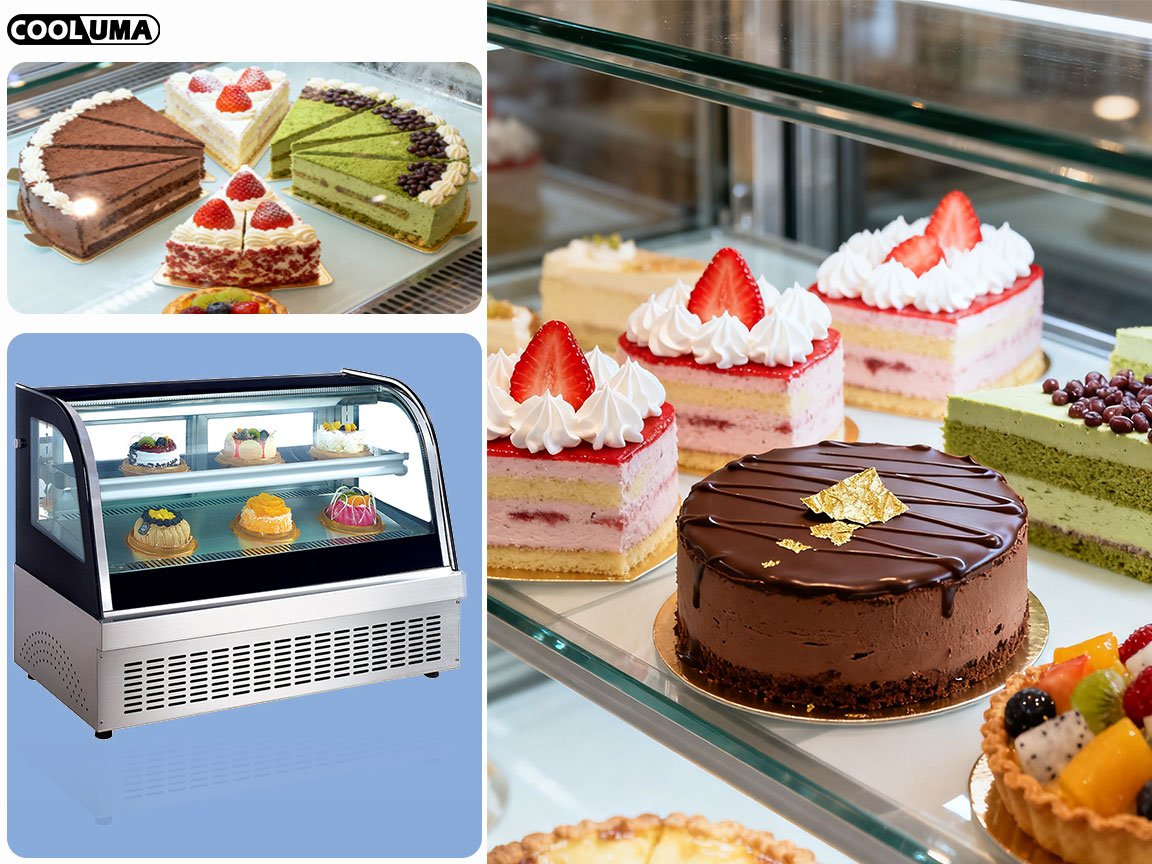
If design is the "aesthetic feature" of high-end display showcases, then functions are their "core strength." Different from the single function of "mere refrigeration" in ordinary display cases, high-end models have developed multiple professional functions centered around "ensuring cake quality" and "improving store operation efficiency."
(I) Precise Temperature and Humidity Control: Ensuring Cake Quality
High-end cakes are extremely sensitive to the environment. Cream cakes will melt if the temperature exceeds 5℃ and freeze if it drops below 0℃. Mousse cakes will crack if the humidity is lower than 50% and become damp if it exceeds 75%. Therefore, one of the core functions of high-end display showcases is "precise temperature and humidity control":
Temperature Control System: Using a "variable-frequency compressor + multi-stage evaporator," the temperature control accuracy can reach ±0.5℃, far higher than the ±2℃ of ordinary display cases. It also supports "zoned temperature control" - some cabinets can be divided into a "refrigeration zone (1 - 5℃, suitable for cream cakes)" and a "fresh-keeping zone (5 - 10℃, suitable for cheesecakes)" to meet the storage needs of various types of cakes.
Humidity Control System: Through an "internal humidifier + humidity sensor," the humidity inside the cabinet is stabilized between 60% - 70%. When the humidity drops below the threshold, the humidifier automatically activates. When it exceeds the threshold, the fresh air system automatically ventilates to prevent issues such as "surface condensation" or "dry texture" of the cakes.
(II) Energy Efficiency and Durability: Reducing Store Operating Costs
The "long-term cost-effectiveness" of commercial equipment is crucial. High-end display showcases have made multiple optimizations in energy efficiency and durability:
1.Energy-Saving Design
Double-layered hollow ultra-clear glass (filled with inert gas) is used, with a thermal conductivity 50% lower than that of ordinary glass, reducing cold loss. The cabinet's insulation layer uses "high-density polyurethane foam" with a thickness of 50mm to further enhance thermal insulation. In addition, the variable-frequency compressor can automatically adjust its speed according to the internal temperature of the cabinet, saving more than 30% energy compared to fixed-frequency compressors.
2.Durability Design
The door hinges are made of 304 stainless steel, supporting over 100,000 openings and closings. The glass doors are equipped with "magnetic suction sealing strips," which have strong sealing performance and are not prone to aging. The bottom of the cabinet is equipped with "heavy-duty universal wheels" (with a braking function), facilitating movement and fixing while preventing the bottom from getting damp and rusting.
(III) Intelligent Management: Improving Operational Efficiency
With the digital upgrade of the bakery industry, high-end display showcases have incorporated more intelligent functions:
Equipped with a "touchscreen control panel," it can display the internal temperature and humidity in real-time and support one-click parameter adjustment. When there is an abnormal temperature (such as a temperature rise due to compressor failure), the system will alert the staff through "acoustic and visual alarms + mobile APP push notifications" to avoid product losses.
Some high-end models can be linked with the store's POS system. "Electronic price tags" are installed on the cabinet glass to display the cake name, price, and ingredients in real-time (such as "Sugar-Free Mousse, ¥68/piece"), reducing the hassle of manual price tag replacement and allowing consumers to quickly obtain product information. Some brands have also developed an "inventory warning function." When the inventory of a certain cake is lower than the set value, the system automatically reminds the staff to restock.
IV. Application Scenarios of Commercial High-End Cake Display Showcases: Adapting to Different Business Needs
The requirements for display showcases vary significantly in different types of bakery scenarios. Through "standardized products + customized services," high-end display showcases have covered a variety of commercial scenarios, becoming the "core display equipment" for stores.
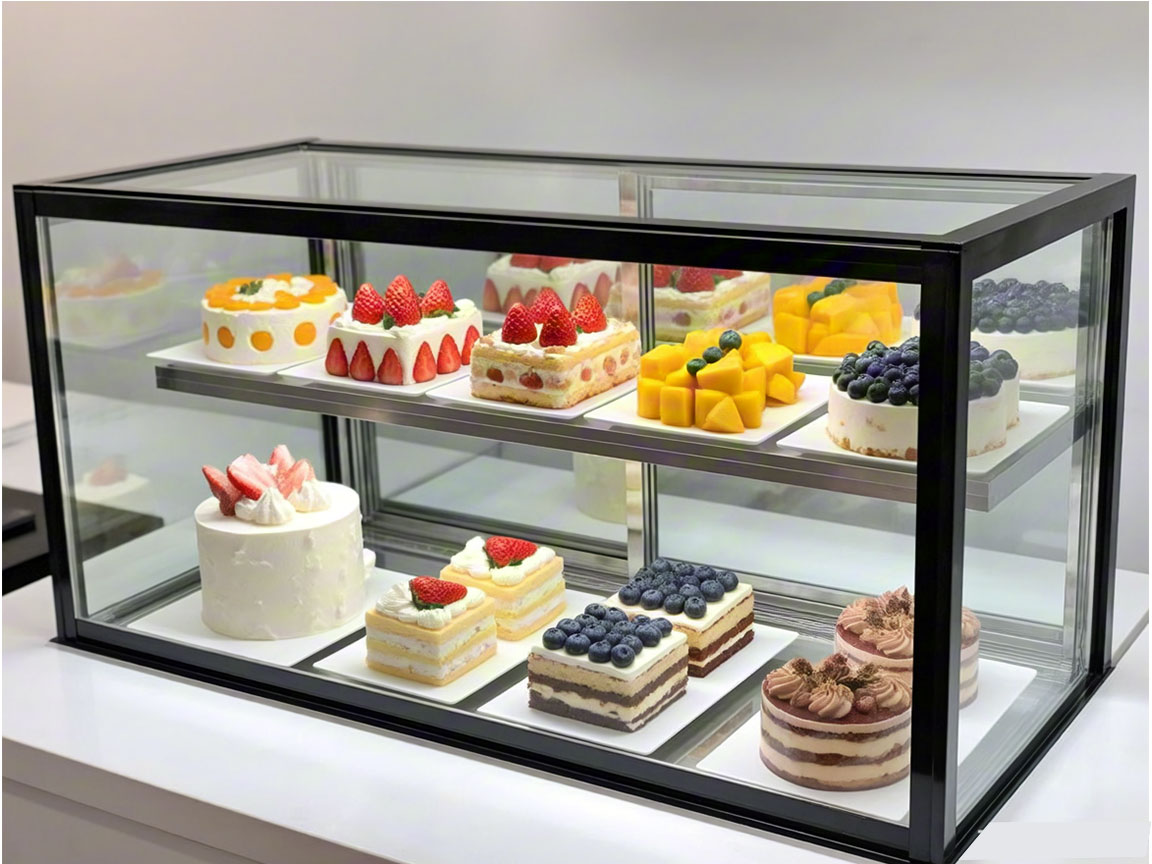
(I) High-End Independent Cake Shops: Emphasizing "Customization and Brand Identity"
The core need of high-end independent cake shops (such as those specializing in custom wedding cakes and French desserts) is to "convey brand identity through display showcases," so they mostly choose "fully customized display showcases." For example, a French dessert shop in Shanghai uses a display showcase with "curved ultra-clear glass + matte black stainless steel," paired with 3000K warm white LED lights. Inside the cabinet, 6 - 8 French mousse cakes are displayed, each with a unique metal nameplate (indicating the name and ingredients), presenting an overall "exquisite and high-end" visual effect that highly aligns with the brand's positioning of "handmade craftsmanship." The display showcases in such stores usually have a smaller capacity (1 - 2 meters long) but higher design costs, with a single unit priced at 15,000 - 30,000 yuan.
(II) Chain Bakery Brands: Focusing on "Standardization and Efficiency"
Chain bakery brands (such as Nayuki, Holiland) have numerous stores distributed widely, and their requirements for display showcases are "standardized design + mass supply + efficient display." Therefore, these brands often collaborate with professional equipment manufacturers to develop "standardized high-end display showcases." For example, they uniformly adopt cabinets that are 1.8 meters long with three adjustable shelf boards, made of 304 stainless steel and ultra-clear glass, and equipped with 4000K neutral white lights. This not only ensures visual consistency across stores but also meets the efficient requirement of "displaying 15 - 20 cakes per cabinet." Meanwhile, the display showcases support "modular splicing." Stores can combine 2 - 3 cabinets into a "display wall" according to the available space to increase the display quantity.
(III) Mall Dessert Counters: Prioritizing "Compactness and Mobility"
Mall dessert counters (such as small dessert shops located in shopping mall corridors or supermarket entrances) have limited space and need to attract passing traffic. Thus, they mostly choose "small mobile high-end display showcases." These display showcases are usually 1 - 1.2 meters long and less than 0.6 meters wide, with universal wheels at the bottom for easy repositioning. In terms of design, they emphasize "visual impact," for example, using "fully transparent glass + top spotlights" to make the cakes visible from a distance. In terms of functions, non-core configurations (such as zoned temperature control) are simplified, but precise temperature control and anti-fog functions are retained. The price of a single unit is approximately 8,000 - 12,000 yuan, suitable for small-scale display (8 - 10 cakes).
(IV) Hotels and High-End Catering: Pursuing "Scene Integration and Grandeur"
The display showcases in hotel dessert areas and high-end western restaurants need to blend with the overall decoration style (such as luxury or modern style) and display a variety of desserts (such as cakes, macarons, chocolates). Therefore, they mostly choose "built-in or large combined display showcases." For example, a five-star hotel's dessert area uses "built-in curved display showcases" that seamlessly connect with the wall. Made of mirror stainless steel and ultra-clear glass, and paired with 4500K neutral white lights, the cabinet displays cakes, dessert towers, and chocolates in layers, occupying no extra space while creating a "high-end and luxurious" atmosphere.
V. Purchase Recommendations for Commercial High-End Cake Display Showcases: Key Points to Avoid Pitfalls
For baking professionals, selecting a suitable high-end cake display showcase requires balancing three principles: "need matching, quality assurance, and cost control." This can be achieved by considering the following five dimensions:
(I) Define Core Needs: Avoid Over-configuration
First, determine your requirements based on the store type, product range, and available space:
For high-end independent cake shops specializing in custom desserts, prioritize models with customizable designs and precise temperature and humidity control.
For chain store outlets with standardized cakes as the main products, opt for models with standardized modules and efficient display capabilities.
For mall counters with limited space, choose compact, mobile models with strong visual appeal.
Avoid blindly pursuing "more features are better." For example, if your store only sells cream cakes, there is no need to choose a model with "zoned temperature control," which can reduce procurement costs.
(II) Verify Core Parameters: Focus on Real Performance
When making a purchase, pay close attention to the following parameters to avoid being misled by false advertising:
Temperature control accuracy: Should be ≤±1℃. You can conduct an on-site test using a thermometer (record the temperature at different locations inside the showcase one hour after closing the door).
Humidity range: Should be 60%-70%. Inquire whether the manufacturer provides an independent humidifier (some low-end models only regulate humidity through condensed water, resulting in poor stability).
Energy consumption: For commercial equipment, focus on the "daily power consumption." High-end models typically consume ≤2 kWh per day. Request third-party test reports from the manufacturer.
Material: Confirm that the stainless steel is 304 grade (test with a magnet; 304 stainless steel is non-magnetic), and the glass is ultra-clear glass (compare with ordinary glass; ultra-clear glass is more transparent without a greenish tint).
(III) Evaluate Manufacturer Strength: Prefer Professional Brands
High-end cake display showcases have high technical barriers, and ordinary equipment manufacturers may not guarantee quality. Therefore, it is recommended to choose professional brands specializing in baking equipment (such as XingXing Cold Chain in China and Liebherr abroad). When evaluating a manufacturer's strength, consider the following three aspects:
Production experience: Check if the manufacturer has over five years of experience in producing baking equipment and whether they have cooperation cases with well-known baking brands.
After-sales service: Ensure they offer on-site installation, a minimum one-year comprehensive warranty, and lifetime maintenance. The after-sales response time should be ≤24 hours (prompt resolution of commercial equipment failures is crucial to avoid operational disruptions).
Customization capabilities: Ascertain if they have an independent design team and can provide customized solutions based on store blueprints (review past customization cases).
(IV) Calculate Long-Term Costs: Don't Overlook Hidden Expenses
In addition to the purchase price, calculate long-term operating costs:
Energy costs: An energy-efficient display showcase (2 kWh per day) incurs an annual electricity bill of approximately $98, while a regular model (4 kWh per day) costs around $196. Over five years, this results in a savings of $490.
Maintenance costs: Inferior display showcases have easily damaged door seals and compressors, with an annual maintenance cost of about $70. High-end models have lower maintenance costs, saving over $280 in five years.
Loss costs: Display showcases with precise temperature and humidity control can reduce cake loss rates (from 5% to 1%). If a store's daily cake sales amount to $1400, it can reduce annual losses by $201.
VI. Future Trends of Commercial High-End Cake Display Showcases: Intelligence and Environmental Friendliness
With consumer upgrading and industry transformation, the development of commercial high-end cake display showcases will exhibit two major trends:
(I) Deepening Intelligence Upgrades
Future high-end display showcases will shift from "passive storage" to "active service":
AI visual recognition: Cameras inside the showcase automatically identify cake types and inventory, update electronic price tags in real-time, and send restocking reminders to staff.
Personalized recommendations: Integrated with the store's membership system, when a member approaches the showcase, the mobile app can push their preferred cakes (e.g., "Your favorite matcha mousse is now available").
Remote management: Enables centralized management of display showcases across multiple stores. Headquarters can monitor real-time temperature, humidity, and energy consumption data of each store and adjust parameters remotely, reducing management costs.
(II) Environmental Friendliness as a Core Competence
Against the backdrop of the "dual carbon" policy, environmental friendliness will become a crucial indicator for high-end display showcases:
Environmentally friendly materials: Increased use of recyclable stainless steel, formaldehyde-free panels, and low-emissivity (Low-E) glass to reduce energy consumption.
Energy-saving technologies: Promotion of "photovoltaic-assisted power supply" (solar panels installed on the top of the showcase to power the lights) and "waste heat recovery" (utilizing heat generated by the compressor for store heating) to further cut down on energy use.
Fluorine-free refrigeration: Complete replacement of traditional R22 refrigerants with environmentally friendly alternatives (such as R600a) to minimize damage to the ozone layer.
Commercial high-end cake display showcases are not merely "expensive ordinary display cases." Instead, they serve as core tools for baking brands to achieve product value enhancement, brand upgrading, and efficiency improvement. Through professional design, precise functionality, and scenario-specific adaptation, they transform cakes from mere "food items" into "visual artworks," satisfying consumers' aesthetic demands while boosting store sales and brand image. In the future, with the advancement of intelligence and environmental friendliness, high-end cake display showcases will be further integrated into the digital ecosystem of the baking industry, becoming important links connecting products, stores, and consumers. For baking professionals, choosing the right high-end display showcase is not just an equipment purchase; it is an investment in the brand's future.
Most popular More «
-
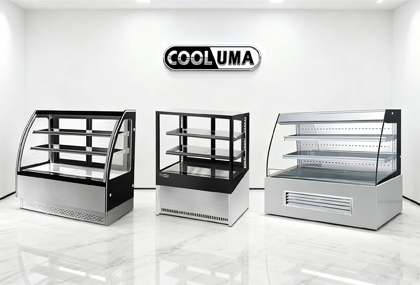
Which country is Cooluma a food display cabinet supplier brand from?
-
What are the advantages of a dual-airflow cake display cabinet?
-
Comprehensive Maintenance Guide for Cooluma Countertop Food Display Cabinets
-
How to solve the core pain points countertop display cases of bakery stores?
-
What is the price of a cake display cabinet in Mumbai?
-
Review of Pastry Countertop Display Cabinet T90C/T90S
-
What techniques are crucial for quality in glass cabinet manufacturing?
-
What are the models available for the Cooluma bread refrigerator with two shelves?
-
The Best Manufacturer of Commercial Italian Gelato Cabinets - Cooluma
-
What is the difference between 5 cake cabinets?





